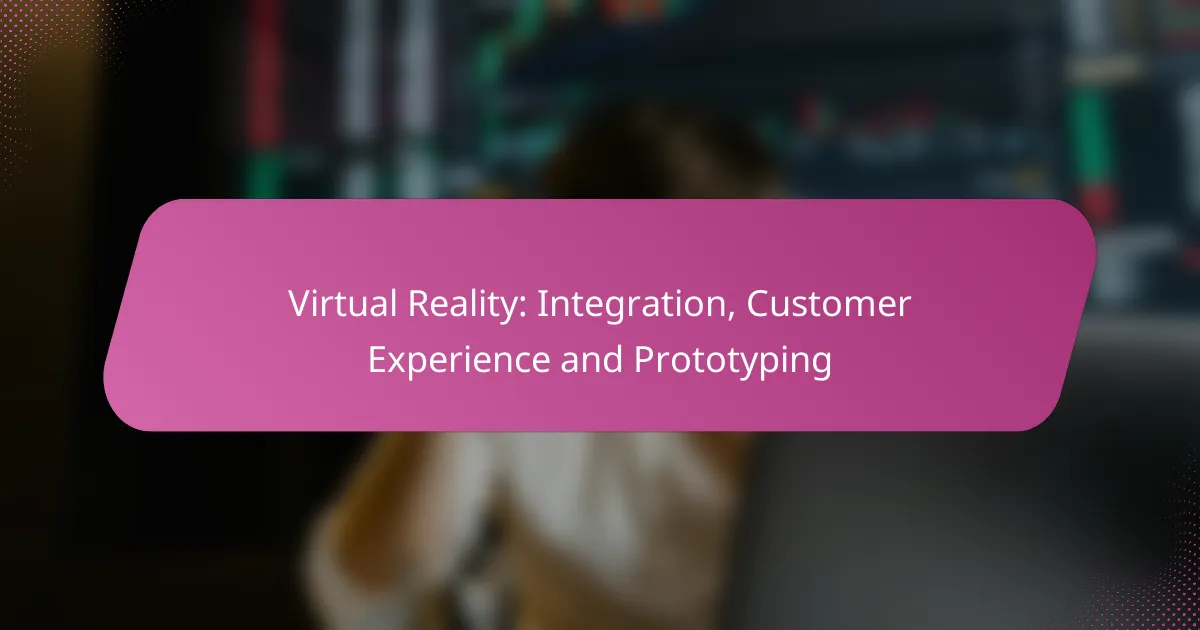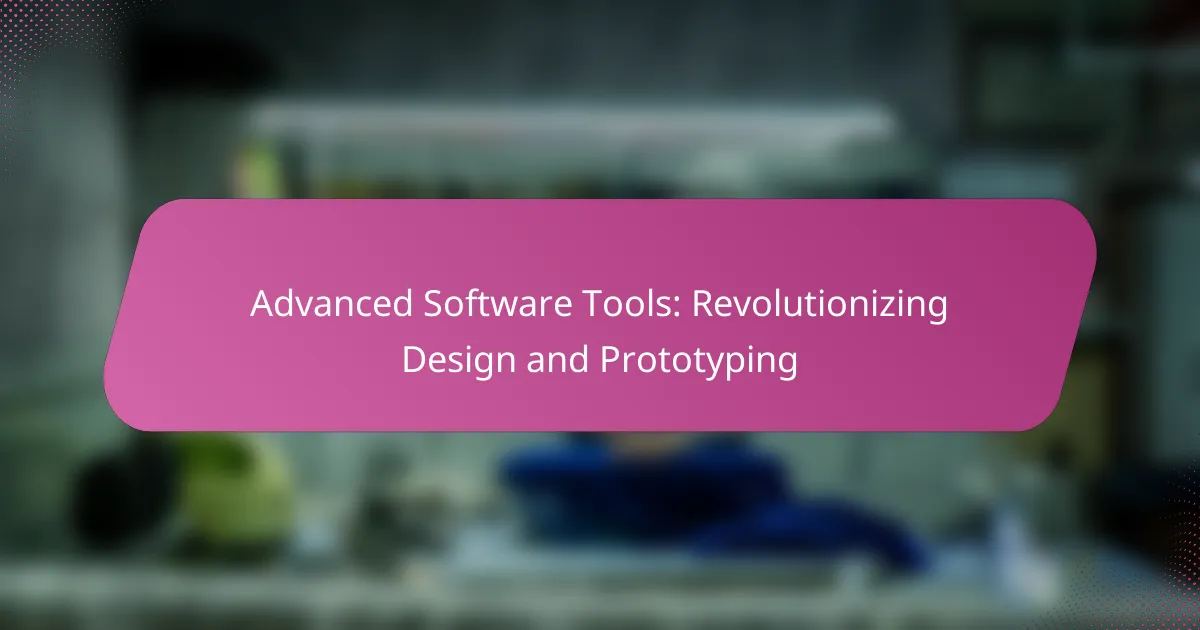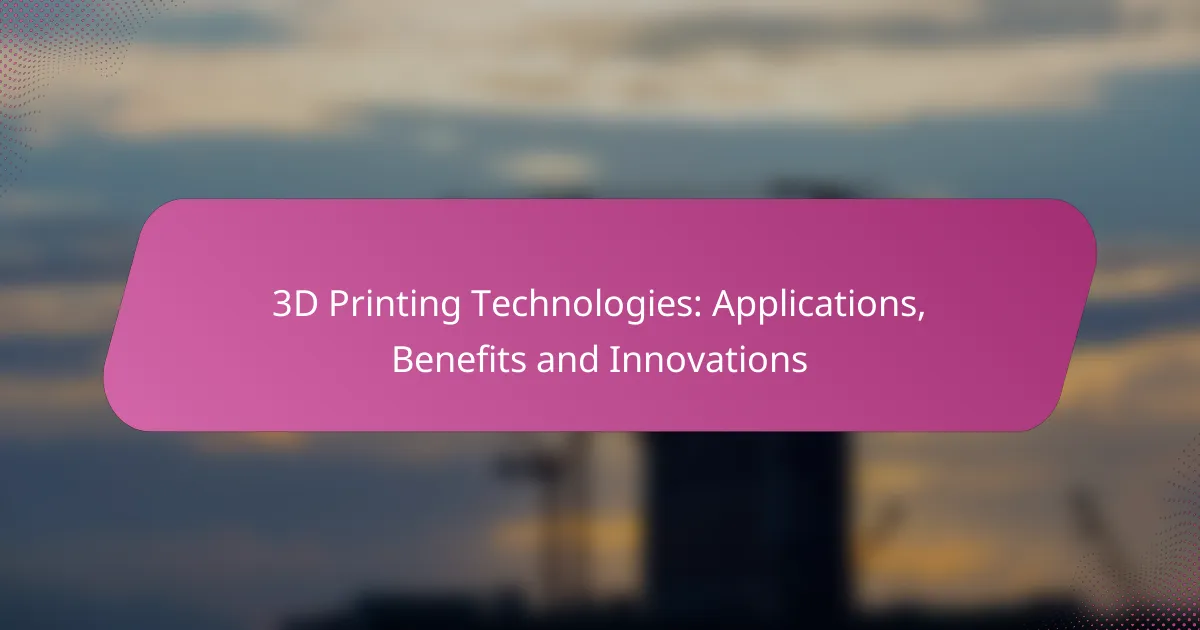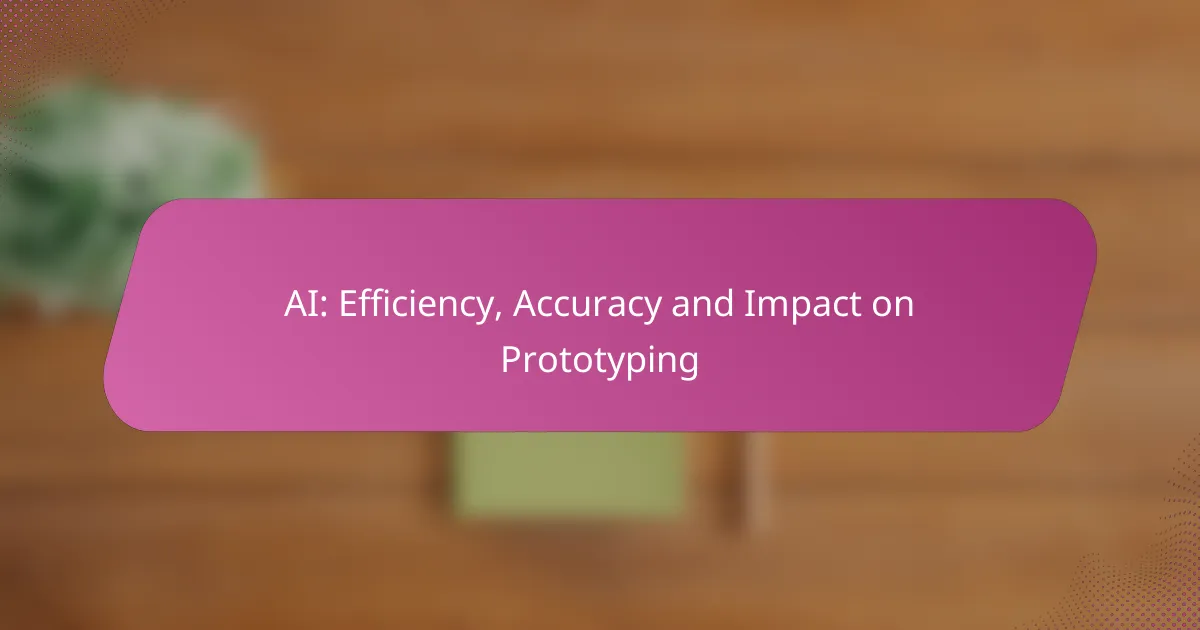Virtual Reality (VR) is revolutionizing customer experience by creating immersive environments that allow shoppers to interact with products in innovative ways. By integrating VR into various business applications, such as training and marketing, companies can enhance operational efficiency and foster deeper engagement with clients. Additionally, VR facilitates rapid prototyping, enabling businesses to create and test 3D models in an immersive setting, which streamlines the design process and improves overall customer satisfaction.
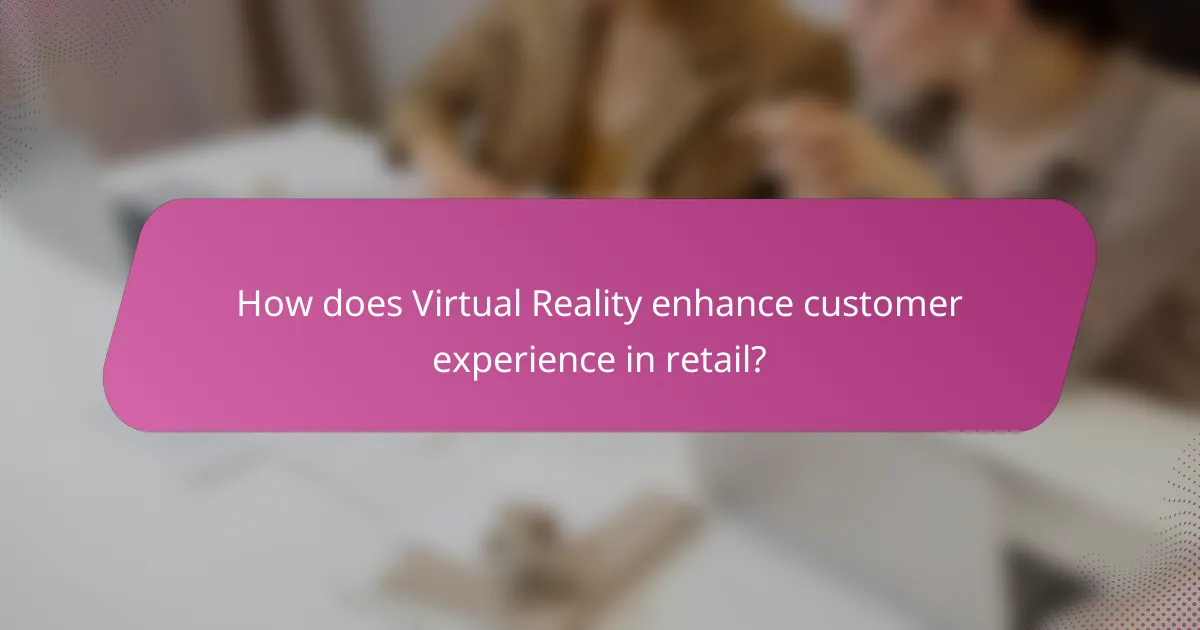
How does Virtual Reality enhance customer experience in retail?
Virtual Reality (VR) significantly enhances customer experience in retail by creating immersive environments that engage shoppers in unique ways. This technology allows customers to interact with products and services in a virtual space, leading to more informed purchasing decisions and increased satisfaction.
Immersive product demonstrations
Immersive product demonstrations using VR provide customers with a realistic view of products in action. For instance, a furniture retailer can allow customers to visualize how a sofa would look in their living room through a virtual setup. This not only helps in understanding the product better but also reduces the likelihood of returns.
Retailers can create engaging scenarios where customers can experience the product’s features and benefits firsthand. This method can lead to higher conversion rates as customers feel more confident in their purchases.
Personalized shopping experiences
VR can tailor shopping experiences to individual preferences, making the process more enjoyable. By analyzing customer data, retailers can create customized virtual environments that showcase products aligned with the shopper’s interests and past purchases. This personalization fosters a deeper connection between the customer and the brand.
For example, a cosmetics brand might use VR to allow customers to explore a virtual store that highlights products based on their skin type or color preferences. This targeted approach can enhance customer loyalty and increase sales.
Virtual try-ons
Virtual try-ons enable customers to see how products, such as clothing or accessories, would look on them without physically trying them on. This technology uses augmented reality within VR to superimpose items onto the customer’s image, providing a realistic preview. This can significantly reduce the hesitation some customers feel about online shopping.
Retailers should ensure that the virtual try-on experience is user-friendly and accurate. Offering a variety of sizes and styles in the virtual fitting room can enhance customer satisfaction and drive purchases, as shoppers feel more confident in their choices.
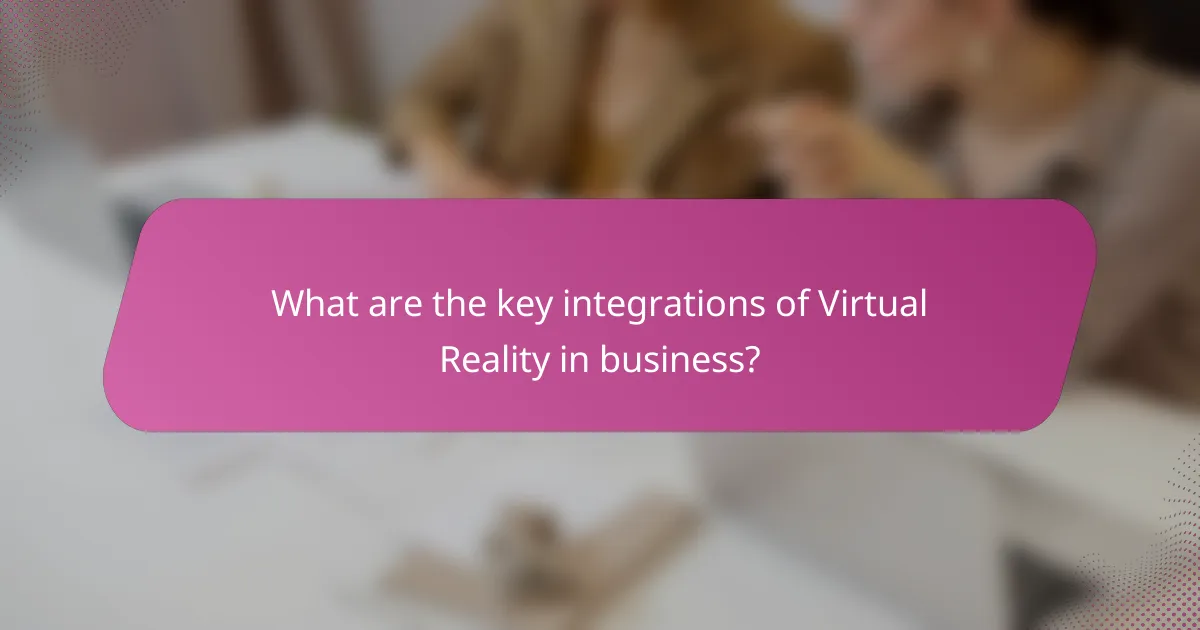
What are the key integrations of Virtual Reality in business?
Key integrations of Virtual Reality (VR) in business include training simulations, remote collaboration tools, and marketing campaigns. These applications enhance customer experience, improve operational efficiency, and foster innovative ways to engage with clients and stakeholders.
Training simulations
Training simulations use VR to create immersive environments where employees can practice skills without real-world consequences. This method is particularly effective in sectors like healthcare, aviation, and manufacturing, where hands-on experience is crucial.
For example, medical professionals can perform virtual surgeries, allowing them to refine their techniques before working on actual patients. Companies should consider the cost of VR equipment and software versus the potential reduction in training time and error rates.
Remote collaboration tools
Remote collaboration tools powered by VR allow teams to meet in virtual spaces, enhancing communication and teamwork regardless of geographical barriers. These tools can simulate a shared workspace, making it easier for participants to interact with 3D models or presentations.
Organizations should evaluate the user experience and accessibility of these tools, ensuring that all team members can engage effectively. Investing in high-quality VR headsets and software can lead to significant improvements in project outcomes and team cohesion.
Marketing campaigns
Marketing campaigns utilizing VR offer customers immersive experiences that can significantly enhance brand engagement. Brands can create virtual showrooms or interactive advertisements that allow potential customers to explore products in a lifelike setting.
For instance, automotive companies often use VR to let customers experience a virtual test drive. Businesses should focus on creating compelling content that resonates with their target audience while being mindful of the technological requirements for effective implementation.
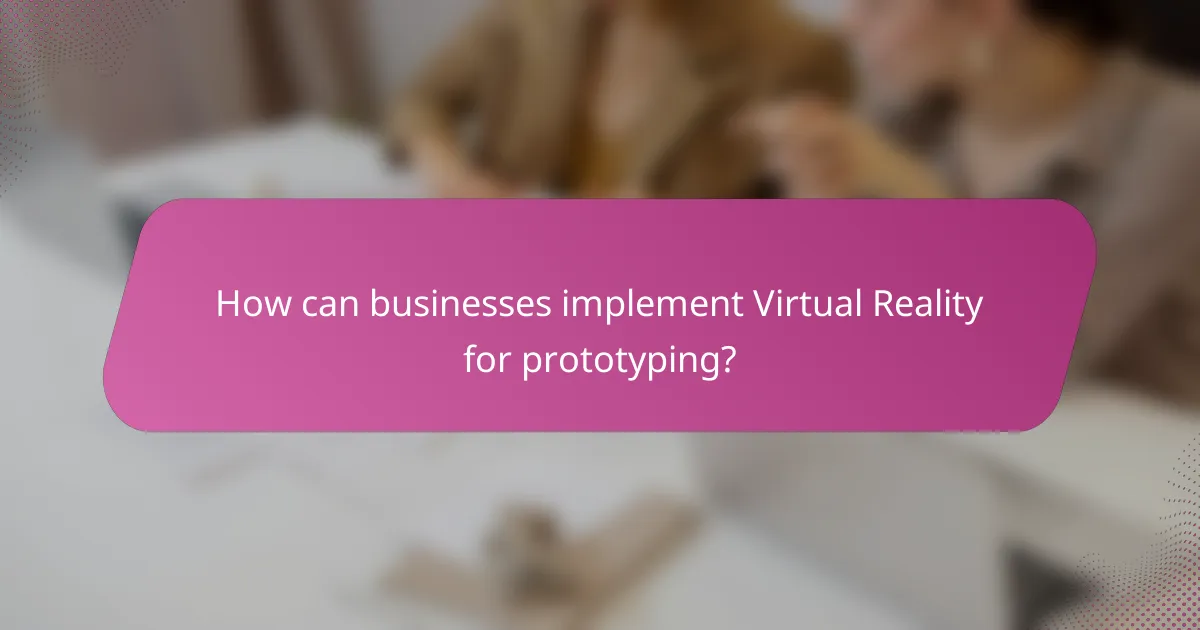
How can businesses implement Virtual Reality for prototyping?
Businesses can implement Virtual Reality (VR) for prototyping by utilizing specialized software and tools that facilitate the creation and testing of 3D models in an immersive environment. This approach allows for rapid iteration and feedback, significantly enhancing the design process and customer experience.
3D modeling software
3D modeling software is essential for creating detailed virtual prototypes. Popular options include Autodesk Maya, Blender, and SketchUp, which allow designers to build complex models that can be manipulated in a VR setting. When selecting software, consider factors such as ease of use, compatibility with VR platforms, and the specific features required for your project.
Additionally, ensure that the software supports file formats compatible with VR applications, such as FBX or OBJ, to streamline the transition from design to virtual testing. This compatibility can save time and reduce errors during the prototyping phase.
Rapid prototyping tools
Rapid prototyping tools enable businesses to quickly create physical or virtual models for testing and evaluation. Tools like Unity and Unreal Engine are commonly used for VR prototyping, allowing for real-time interaction and visualization. These platforms can significantly reduce the time needed to develop and refine prototypes.
When using rapid prototyping tools, focus on creating a minimum viable product (MVP) that captures the core features of your design. This approach allows for faster feedback and adjustments, ultimately leading to a more refined final product.
Feedback collection mechanisms
Collecting feedback is crucial for improving prototypes in VR. Implement mechanisms such as surveys, focus groups, or direct observation to gather insights from users interacting with your virtual models. Tools like Google Forms or specialized VR feedback applications can facilitate this process.
Encourage participants to provide specific feedback on usability, design elements, and overall experience. This information is invaluable for making informed adjustments and ensuring that the final product meets user needs and expectations.

What are the costs associated with Virtual Reality integration?
The costs associated with Virtual Reality (VR) integration can vary significantly based on the scale and complexity of the project. Key expenses typically include hardware, software licensing, and training, each of which can impact the overall budget considerably.
Hardware expenses
Hardware expenses for VR integration can range from a few hundred to several thousand dollars, depending on the quality and specifications of the equipment. Essential components include VR headsets, powerful computers or consoles, and additional peripherals like motion sensors and controllers.
For instance, entry-level VR headsets may cost around $300, while high-end options can exceed $1,000. Organizations should assess their needs and choose hardware that balances performance with budget constraints.
Software licensing fees
Software licensing fees can vary widely based on the applications and platforms chosen for VR experiences. Some software may require a one-time purchase, while others operate on a subscription model, costing anywhere from $20 to several hundred dollars per month.
It’s crucial to evaluate the features and support offered by different software solutions to ensure they align with the intended use of VR. Additionally, consider any potential costs for updates or additional features in the future.
Training and support costs
Training and support costs are essential for successful VR integration, as staff need to be proficient in using the technology. Training programs can range from a few hundred to several thousand dollars, depending on the complexity of the VR system and the number of employees involved.
Investing in comprehensive training can mitigate common pitfalls and enhance user experience. Organizations should also consider ongoing support costs, which may include technical assistance or maintenance contracts, to ensure smooth operation of the VR systems.
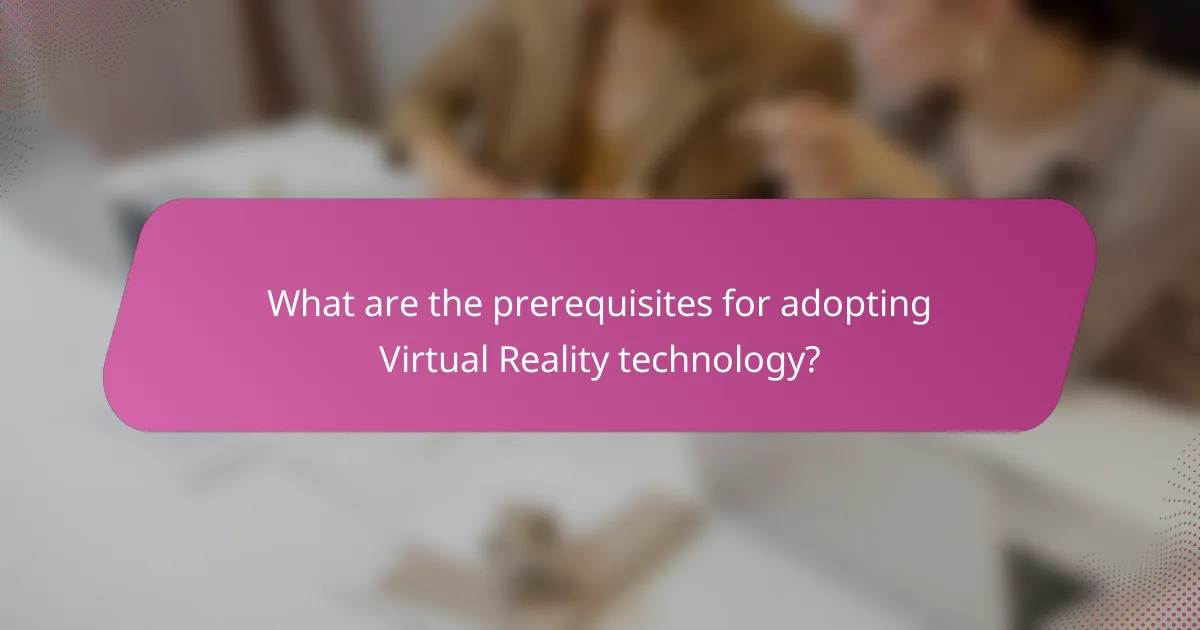
What are the prerequisites for adopting Virtual Reality technology?
Adopting Virtual Reality (VR) technology requires a solid foundation in both technical infrastructure and staff training. Organizations must ensure they have the necessary hardware, software, and skilled personnel to effectively implement and utilize VR solutions.
Technical infrastructure
To successfully integrate VR technology, businesses need robust technical infrastructure, including high-performance computers, VR headsets, and reliable internet connectivity. A typical setup may involve powerful graphics cards and processors to handle the demanding requirements of VR applications.
Additionally, organizations should consider software compatibility and the ability to support VR platforms. This may involve investing in VR development tools or platforms that align with their specific use cases, such as training simulations or customer engagement experiences.
Staff training requirements
Staff training is essential for maximizing the benefits of VR technology. Employees must be familiar with both the hardware and software components, which may involve hands-on training sessions or workshops. Understanding how to create, manage, and utilize VR content is crucial for effective implementation.
Organizations should also encourage ongoing education and skill development in VR technologies. This could include attending industry conferences, online courses, or collaborating with VR experts to stay updated on best practices and emerging trends.
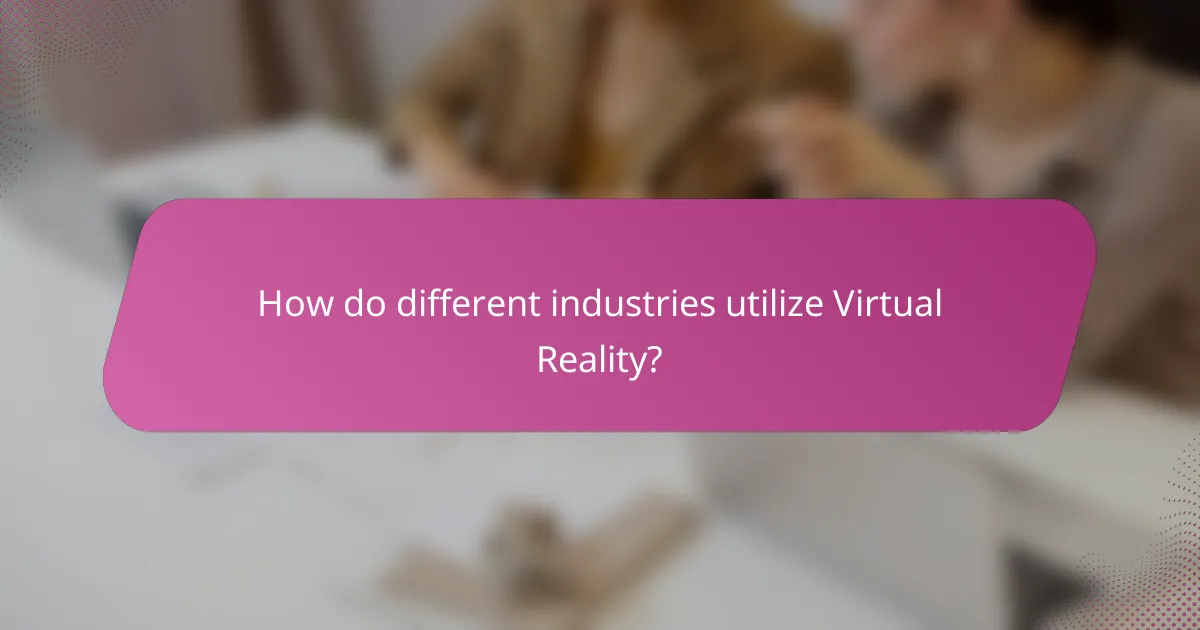
How do different industries utilize Virtual Reality?
Various industries leverage Virtual Reality (VR) to enhance training, improve customer experiences, and streamline prototyping processes. By immersing users in simulated environments, VR facilitates hands-on learning and interactive engagement across sectors.
Healthcare training
In healthcare, VR is used extensively for training medical professionals in a risk-free environment. Trainees can practice surgical procedures, patient interactions, and emergency response scenarios without endangering real patients.
VR training programs often simulate realistic clinical situations, allowing healthcare workers to develop skills and confidence. For example, surgical simulations can provide feedback on technique and precision, helping to refine abilities before actual procedures.
When implementing VR in healthcare training, institutions should consider the cost of technology and the need for ongoing updates to content. Ensuring that the VR scenarios reflect current medical standards is crucial for effective training outcomes.
